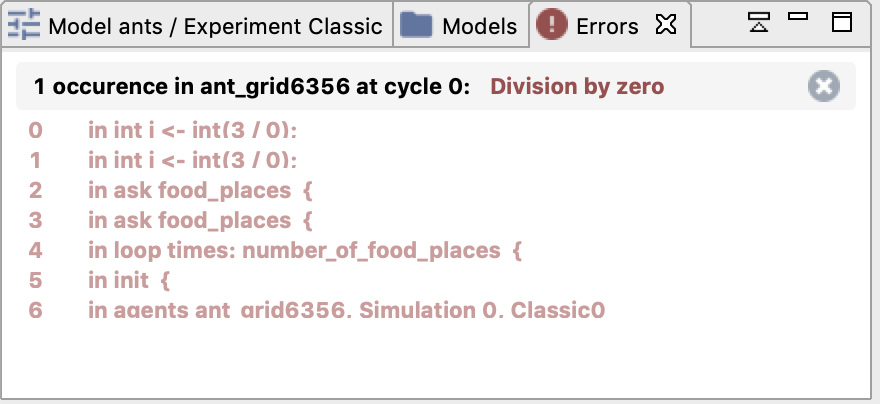-
Notifications
You must be signed in to change notification settings - Fork 99
ErrorsView
Whenever a runtime error, or a warning, is issued by the currently running experiment, a view called "Errors" is opened automatically. This view provides, together with the error/warning itself, some contextual information about who raised the error (i.e. which agent(s)) and where (i.e. in which portion of the model code). As with other "status" in GAMA, errors will appear in red color and warnings in orange.
Since an error appearing in the code is likely to be raised by several agents at once, GAMA groups similar errors together, simply indicating which agent(s) raised them. Note that, unless the error is raised by the experiment agent itself, its message will indicate that at least 2 agents raised it: the original agent and the experiment in which it is plunged.
When we unfold the error, to have an idea of its location in the code. In addition clicking on one of the lines should highlight the corresponding line in the code.

One of the most current (and sometimes the most mysterious) error is linked to an empty agent (with the value nil) on which we want to access to one of its attributes. It is expressed by Cannot evaluate ATTRIBUTE_NAME as the target agent is nil or Java nil. In this case, modelers have to check carefully their codes to be sure that all the agent variables have a not nil value.

- Installation and Launching
- Workspace, Projects and Models
- Editing Models
- Running Experiments
- Running Headless
- Preferences
- Troubleshooting
- Introduction
- Manipulate basic Species
- Global Species
- Defining Advanced Species
- Defining GUI Experiment
- Exploring Models
- Optimizing Model Section
- Multi-Paradigm Modeling
- Manipulate OSM Data
- Diffusion
- Using Database
- Using FIPA ACL
- Using BDI with BEN
- Using Driving Skill
- Manipulate dates
- Manipulate lights
- Using comodel
- Save and restore Simulations
- Using network
- Headless mode
- Using Headless
- Writing Unit Tests
- Ensure model's reproducibility
- Going further with extensions
- Built-in Species
- Built-in Skills
- Built-in Architecture
- Statements
- Data Type
- File Type
- Expressions
- Exhaustive list of GAMA Keywords
- Installing the GIT version
- Developing Extensions
- Introduction to GAMA Java API
- Using GAMA flags
- Creating a release of GAMA
- Documentation generation